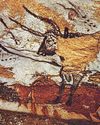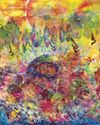
The English philosopher and novelist Iris Murdoch (1919-1999) believed that although we may never fully know reality itself, love may help us glimpse something of it, since love alerts us to reality as it exists independently of our egos. How it does so is a mystery, but we seem to recognise that it does.
Murdoch set out her view of love in a number of essays on art and morals published between 1959 and 1969, which were subsequently republished, along with others, in the compilation Existentialists and Mystics (1997). I shall try to summarise her view and, in the final section, discuss three criticisms.
Something Other than Oneself is Real
Whereas Plato believed that art distracts us from reality, Murdoch argues in The Sublime and the Good (1959) that, on the contrary, art, by virtue of love, alerts us to what is real:
“Art and morals are, with certain provisos… one. Their essence is the same. The essence of both of them is love. Love is the perception of individuals. Love is the extremely difficult realisation that something other than oneself is real. Love and so art and morals, is the discovery of reality. What stuns us into a realisation of our supersensible destiny [ie, our mortality] is not, as Kant imagined, the formlessness of nature, but rather its unutterable particularity; and the most particular and individual of all things is the mind of man” (p.215. All page numbers are from Existentialists and Mystics). Murdoch claims that art, morals, and love share the same
This story is from the February/March 2022 edition of Philosophy Now.
Start your 7-day Magzter GOLD free trial to access thousands of curated premium stories, and 9,000+ magazines and newspapers.
Already a subscriber ? Sign In
This story is from the February/March 2022 edition of Philosophy Now.
Start your 7-day Magzter GOLD free trial to access thousands of curated premium stories, and 9,000+ magazines and newspapers.
Already a subscriber? Sign In

Metaphors & Creativity
Ignacio Gonzalez-Martinez has a flash of inspiration about the role metaphors play in creative thought.

Medieval Islam & the Nature of God
Musa Mumtaz meditates on two maverick medieval Muslim metaphysicians.

Robert Stern
talks with AmirAli Maleki about philosophy in general, and Kant and Hegel in particular.

Volney (1757-1820)
John P. Irish travels the path of a revolutionary mind.

IT'S A WONDERFUL LIFE
Becky Lee Meadows considers questions of guilt, innocence, and despair in this classic Christmas movie.

"I refute it thus"
Raymond Tallis kicks immaterialism into touch.

Cave Girl Principles
Larry Chan takes us back to the dawn of thought.

A God of Limited Power
Philip Goff grasps hold of the problem of evil and comes up with a novel solution.

A Critique of Pure Atheism
Andrew Likoudis questions the basis of some popular atheist arguments.

Exploring Atheism
Amrit Pathak gives us a run-down of the foundations of modern atheism.